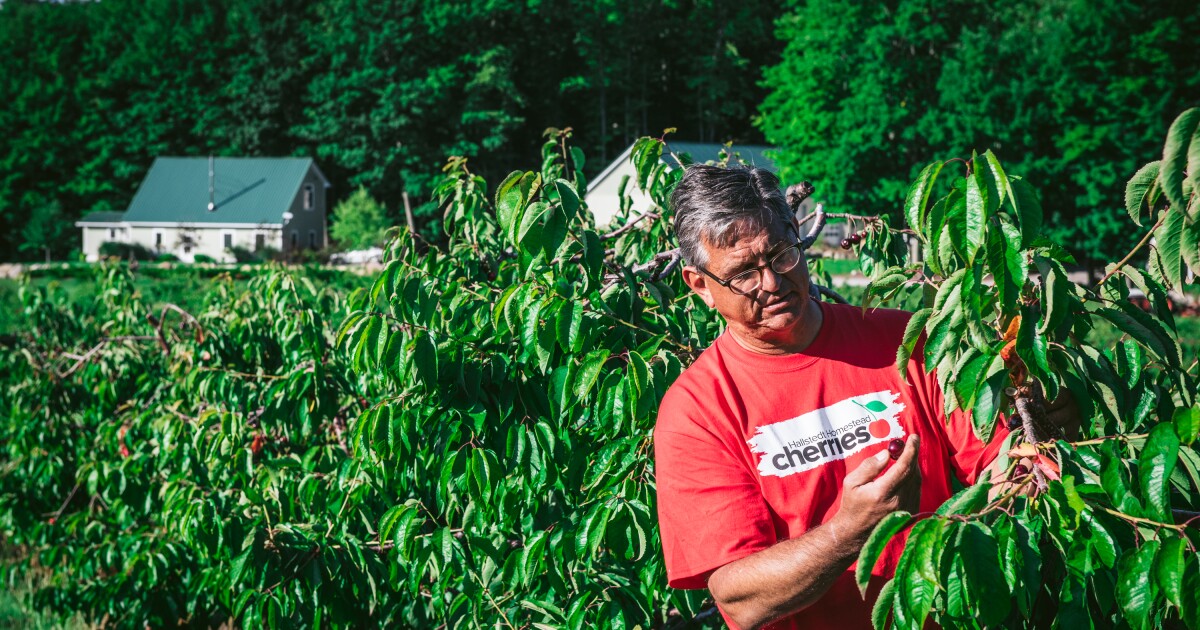The Leelanau Peninsula: A Fruitful Yet Challenging Landscape for Farmers
Nestled in the heart of Michigan, the Leelanau Peninsula, affectionately known as the state’s “pinky,” stretches 30 miles into the azure waters of Lake Michigan. This picturesque region, characterized by its rolling hills and temperate climate, has long been celebrated for its ideal conditions for fruit cultivation, particularly cherries. However, as farmers like Phil Hallstedt are discovering, the path to prosperity in this idyllic setting is fraught with challenges.
The Beauty and Bounty of Leelanau
The Leelanau Peninsula is a visual feast, with its lush orchards and stunning lake views. The unique geography and the lake’s moderating effect on temperatures create a microclimate that is perfect for growing a variety of fruits. Cherries, in particular, thrive here, making the region a significant player in Michigan’s agricultural landscape.
Phil Hallstedt, a cherry farmer, describes the beauty of the landscape as something that “never gets old.” Yet, he also acknowledges the increasing difficulties of maintaining a successful cherry farm. “Cherries are so, so risky,” he laments, highlighting the unpredictability that comes with farming in this region.
The Shift to U-Pick and Agritourism
In response to the mounting pressures of traditional farming, Hallstedt has pivoted his business model to a U-Pick operation. This innovative approach allows visitors to pay for the experience of harvesting their own cherries, creating a more interactive and engaging way to enjoy the fruit. Additionally, Hallstedt plans to capitalize on the region’s burgeoning tourist economy by opening campsites on his property, further diversifying his income streams.
This transition was not made lightly. After years of juggling part-time jobs to make ends meet, Hallstedt faced a crossroads. “Two years ago, I was ready to throw in the towel,” he recalls. However, with the encouragement of his wife, he embraced the challenge of reinventing their farm. “Together we’re trying this new business model,” he says, emphasizing the importance of adaptability in today’s agricultural landscape.
The Economic Landscape for Farmers
The challenges faced by Hallstedt are not unique. A recent USDA study reveals that the percentage of farmers relying on off-farm income has surged from 37% in 1974 to approximately 84% today. This shift underscores a troubling trend: many small farms are struggling to survive, leading to increased consolidation in the agricultural sector.
U.S. Secretary of Agriculture Tom Vilsack has pointed out that the reliance on off-farm income is a symptom of deeper issues within the agricultural economy. “Why can’t the farm work harder and generate more farm income?” he questions, highlighting the need for systemic changes to support small farmers.
Thinner Profit Margins and Rising Costs
The economic pressures on farmers are exacerbated by rising costs of inputs such as seeds, fertilizers, and labor, while prices for produce remain stagnant or even decline. For Hallstedt, the numbers tell a stark story: it costs about 35 cents to grow a pound of tart cherries, yet farmers received only 12 cents per pound last year. “You can’t sustain that,” he asserts, illustrating the unsustainable nature of current farming practices.
The 2024 growing season has been particularly harsh for Michigan cherry farmers, with heavy spring rains devastating much of the crop. In response, the state’s governor has called for federal relief to support struggling growers.
The Struggle for Small Farms
As agricultural economist Daniel Munch notes, smaller farms face significant challenges competing in a global market dominated by larger operations. “Little guys” often find it increasingly difficult to produce at competitive prices, leading to a cycle of consolidation that threatens the very fabric of rural communities.
While off-farm income can provide stability and health benefits, it also reflects a troubling reality: many farmers are unable to rely solely on their agricultural endeavors for financial security. Alan Spell, an assistant extension professor, emphasizes that the need for supplemental income is a reality for many in the industry, particularly for those just starting out.
Exploring New Avenues for Income
In light of these challenges, farmers are exploring innovative ways to diversify their income. Hallstedt’s foray into agritourism is one example of how farmers can adapt to changing market conditions. The recent introduction of a farm-stay ordinance in Leelanau Township allows farmers to open campsites, providing an additional revenue stream while preserving the region’s agricultural heritage.
“Once that house goes up, it’s gone. It will always be housing,” Hallstedt warns, emphasizing the importance of maintaining farmland in the face of urban development. His commitment to preserving the land reflects a broader concern among farmers about the future of agriculture in the region.
Conclusion: A Hopeful Future
The Leelanau Peninsula, with its breathtaking landscapes and rich agricultural history, faces a complex future. Farmers like Phil Hallstedt are navigating a challenging economic landscape, but their resilience and adaptability offer hope. By embracing new business models and diversifying income sources, they are not only working to sustain their farms but also to preserve the unique character of this cherished region.
As Hallstedt puts it, “We love this land and believe it’s special.” It is this passion and commitment that will ultimately shape the future of farming in the Leelanau Peninsula, ensuring that its beauty and bounty endure for generations to come.


:max_bytes(150000):strip_icc()/GDPReport_final-6b51e62b20c64506bf106b37cec1f9de.png?ssl=1)
















